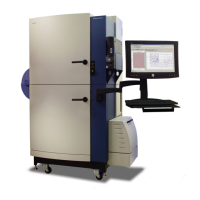FLIPR
®
Tetra High Throughput Cellular Screening System User Guide
0112-0109 H 277
Determining Negative Control Correction
The negative control correction factor is derived by first calculating the
mean fluorescence of each of the samples of the negative control wells.
The mean of Sample 1 is divided by the mean of each of the samples to
give the sample-specific correction factor.
Each sample is multiplied by its sample-specific correction factor.
For example, A1 Sample 1 is multiplied by 1.00.
Sample Time
Well
A1
– Ctrl
A2
– Ctrl
A3
– Ctrl
Mean
Correction
Factor
1 0 8960 8925 8930 8938 1.00
2 5 9194 9030 8836 9017 0.99
3 10 9408 8925 8648 8994 0.99
4 20 9632 8820 8648 9033 0.99
5 25 9632 9240 8648 9173 0.97
6 30 9856 8925 8930 9237 0.997
Sample Time
Well
A1
– Ctrl
A2
– Ctrl
A3
– Ctrl
A4
Exp
A5
Exp
A6
Exp
A7
+ Ctrl
A8
+ Ctrl
A9
+ Ctrl
1 0 8960 8925 8930 8938 8924 8976 8900 8930 8961
2 5 9194 8940 8748 8957 8643 9088 8370 9027 9177
3 10 9314 8836 8562 9172 8643 9189 8547 9027 9585
4 20 9536 8732 8562 48560 48015 42412 50223 48391 55064
5 25 9343 8963 8389 39120 39518 34629 45755 45590 49955
6 30 9560 8657 8662 31719 32932 28693 43165 46502 49955
Note: The negative control correction factor wells contain the same
cells and dyes as the experimental and positive control wells.

